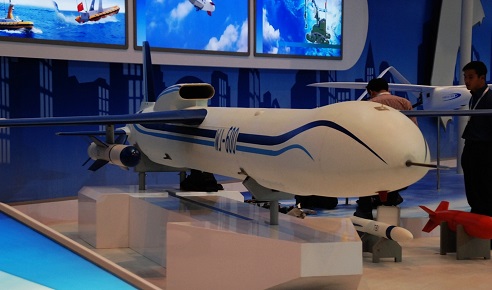Naval Drone Swarms
Swarming is a tactic for modern warfare first articulated in the 1990s. Arguably the best definition of swarming in modern conflict comes from John Arguilla and David Ronfelt:
"Swarming is a seemingly amorphous, but deliberately structured, co-ordinated, strategic way to strike from all directions at a particular point or points, by means of a sustainable pulsing of force and/or fire, close-in as well as from stand-off positions. This notion of “force and/or fire” may be literal in the case of military or police operations, but metaphorical in the case of NGO activists, who may, for example, be blocking city intersections or emitting volleys of emails and faxes. Swarming will work best — perhaps it will only work — if it is designed mainly around the deployment of myriad, small, dispersed, networked maneuver units. Swarming occurs when the dispersed units of a network of small (and perhaps some large) forces converge on a target from multiple directions. The overall aim is sustainable pulsing — swarm networks must be able to coalesce rapidly and stealthily on a target, then dissever and redisperse, immediately ready to re-combine for a new pulse.”
The following links discuss the application of unmanned naval systems for swarm operations.
DOD Releases Video of 103 Drone Swarm
9 January 2017 - The Department of Defense's Strategic Capabilities Office, partnering with Naval Air Systems Command, successfully demonstrated one of the world’s largest micro-drone swarms at China Lake, California. The test, conducted in October 2016 consisted of 103 Perdix drones launched from three F/A-18 Super Hornets. The micro-drones demonstrated advanced swarm behaviors such as collective decision-making, adaptive formation flying, and self-healing.
Johns Hopkins APL, Navy Demonstrate High-Speed, Autonomous Surface Patrol Capability

13 December 2016 - After a year of internal research and development, the Johns Hopkins University Applied Physics Laboratory in Laurel, Maryland, recently conducted a large, at-sea demonstration of swarming unmanned surface vessels (USV). The experiment — done in collaboration with the Surface Targets Branch of the Naval Air Warfare Center Weapons Division, Port Hueneme, California — was designed to advance the state of the art of collaborative, autonomous USV behaviors to higher speeds and larger numbers of vessels.
The successful demonstration took place in late September and involved six surface target boats operating together at high speeds, using hardware and software that APL developed and integrated with the reliable boat control system created by the Surface Targets Branch.
“To our knowledge, this represents the first time that six autonomous vessels have ‘swarmed’ at tactically relevant speeds,” said Jim Horris, APL program manager for Autonomy Test and Evaluation. “And the joint team implemented a full safety protocol without the need for additional safety boats.”
The demonstration scenario was an unmanned patrol of a restricted maritime area such as a range or marine preserve. The boats traveled at speeds up to 35 knots to execute fully autonomous behaviors such as cooperative persistent search, target detection and tracking, rendezvous, pursuit and escort.
The surface vessel control system, employed throughout the fleet of high-speed surface targets worldwide and refined over the last 15 years by the Surface Targets Branch, provided a distinct advantage during integration and testing. The operator control station software developed by APL and coupled with the Navy system allowed safe, broad command and control capabilities as well as “on-the-fly” mission planning.
In addition to achieving this milestone capability, the demonstration provided great insight into the challenges of swarming at high speeds, as well as changes needed by the testing community to establish the operational “trust” necessary for adoption of autonomous systems.
APL is exploring next steps with the Navy and other Department of Defense stakeholders to incorporate the technology into operations and related development programs.
|
Evaluating China's Anti-Ship Drone Swarms 21 March 2013 - How can the PLA's growing UAV fleet be countered at sea? |
 |
Unmanned Systems for EM-Cyber Warfare
27 December 2012 - Drones add agility and quantity to this critically important domain.
The Next Wave - Swarming Underwater Drones
8 November 2012 - Quadrotor swarm experiments have produced some interesting results, including potential for future military applications. Now some researchers in Germany are working to transition these concepts to the underwater realm.
31 August 2012 - Technologies developed for the civilian drone market will have naval applications.
Wireless Energy Transmission: Powering Future Naval Drones
16 August 2012 - The introduction of wireless power transmission technology will add tremendous capabilities to future naval drones.
ScanEagles Used in Drone Swarm Testing
14 August 2012 – In June, Boeing and Johns Hopkins University Applied Physics Laboratory teamed to test swarming functions using two ScanEagle drones. According to a Boeing press release, an operator using a laptop and radio “was able to connect with autonomous UAVs, task them and obtain information without using a ground control station.” The technology mimics a swarm of insects, synchronizing movement of the drones to autonomously conduct searches and collect intelligence.
Although UAVs have delivered many benefits to those navies using them, the number of sailors and contractors required to operate and process the information from the drones has not necessarily resulted in personnel cost savings required of manned aircraft. The need for further automation in drone operations is one of the drivers for swarming technology. "Swarm network technology has the potential to offer more missions at less risk and lower operating costs," said Gabriel Santander, program director of Advanced Autonomous Networks for Boeing Phantom Works.
comments powered by Disqus